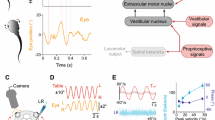Abstract.
Pseudo-inverse kinematics, under which small movements are produced by the least possible sum square changes in motor command, has been proposed as a unifying principle for the elimination of redundancy in general biological motor control systems (Pellionisz 1984) and in particular in the oculomotor system (Daunicht 1988, 1991). We have noted elsewhere (Dean et al. 1999) that this principle is incomplete without first specifying a parameterisation of motor command space and we proposed that the relevant motor command parameter is summed motor unit firing rate. Under this assumption we were able to show that pseudo-inverse control of the horizontal extraocular muscles is consistent with available motor pool firing rate data. In this paper we extend this result to three dimensions and all six extraocular muscles, showing that pseudo-inverse control is consistent with published firing rate data for a realistic model of oculomotor kinematics. We suggest that pseudo-inverse control may represent a common currency for modular control of many degree of freedom systems while its implementation may be a consequence of the minimisation of a more ecologically relevant parameter such as post-saccadic retinal slip.
Similar content being viewed by others
References
Daunicht W (1988) A biophysical approach to the spatial function of eye movements, extraocular proprioception and the vestibulo-ocular reflex. Biol Cybern 58:225–233
Daunicht W (1991) Autoassociation and novelty detection by neuromechanics. Science 253:1289–1291
Dean P, Porrill J (1998) Pseudo-inverse control in biological systems: a learning mechanism for fixation stability. Neural Netw 11:1205–1208
Dean P, Porrill J, Warren PA (1999) Optimality of position commands to horizontal eye muscles: a test of the minimum-norm rule. J Neurophysiol 81:735–757
Fuchs AF, Scudder CA, Kaneko CRS (1988) Discharge patterns and recruitment order of identified motoneurons and internuclear neurons in the monkey abducens nucleus. J Neurophysiol 60:1874–1895
Gamlin PDR, Mays LE (1992) Dynamic properties of medial rectus motoneurons during vergence eye-movements. J Neurophysiol 67:64–74
Haustein W (1995) Mathematics of three dimensional eye rotations. Vision Res 12:1727–1739
Keller EL (1981) Oculomotor neuron behavior. In: Zuber BL (ed) Models of oculomotor behavior and control. CRC, Boca Raton, FL, pp 1–19
King WM, Fuchs AF, Magnin M (1981) Vertical eye-movement related responses of neurons in midbrain near interstitial nucleus of cajal. J Neurophysiol 4: 549–562
Klein CA, Huang CH (1983) Review of pseudoinverse control for use with kinematically redundant manipulators. IEEE Trans Sys Man Cybern 13:245–250
Kono R, Poukens V, Demer JL (2002) Quantitative analysis of the structure of the human extraocular muscle pulley system. Invest Ophthalmol Vis Sci 43(9):2923–2932
Lutkepohl H (1996) Handbook of matrices. Wiley, New York
Miller JM, Robinson DA (1984) A model of the mechanics of binocular alignment. Comput Biomed Res 17: 436–470
Miller JM, Shamaeva I (1995) Orbit 1.5 gaze mechanics simulation user’s manual. Eidactics, San Francisco
Miller JM, Shamaeva I, Pavlovski DS (1995) Orbit 1.5 gaze mechanics simulation. Eidactics, San Francisco
Miller JM, Bockisch CJ, Pavlovski DS (2002) Missing lateral rectus force and absence of medial rectus co-contraction in ocular convergence. J Neurophysiol 87:2421–2433
Pellionisz AJ (1984) Coordination–-a vector-matrix description of transformations of overcomplete cns coordinates and a tensorial solution using the moore-penrose generalized inverse. J Theor Biol 110:353–375
Porrill J, Warren PA, Dean P (2000) A simple control law generates Listing’s positions in a detailed model of the extraocular muscle system. Vision Res 40:3743–3758
Robinson DA (1975) A quantitative analysis of extraocular muscle cooperation and squint. Invest Ophthalmol Vis Sci 14:801–825
van Gisbergen JAM, van Opstal AJ (1989) In: Goldberg ME (ed) The neurobiology of saccadic eye movements. Elsevier, Amsterdam
Warren PA (1999) Mathematical models of ocular mechanics and control. PhD Thesis. The University of Sheffield, Sheffield, UK
Author information
Authors and Affiliations
Corresponding author
Rights and permissions
About this article
Cite this article
Warren, P., Porrill, J. & Dean, P. Consistency of Listing’s law and reciprocal innervation with pseudo-inverse control of eye position in 3-D. Biol. Cybern. 91, 1–9 (2004). https://doi.org/10.1007/s00422-004-0486-2
Received:
Accepted:
Published:
Issue Date:
DOI: https://doi.org/10.1007/s00422-004-0486-2




